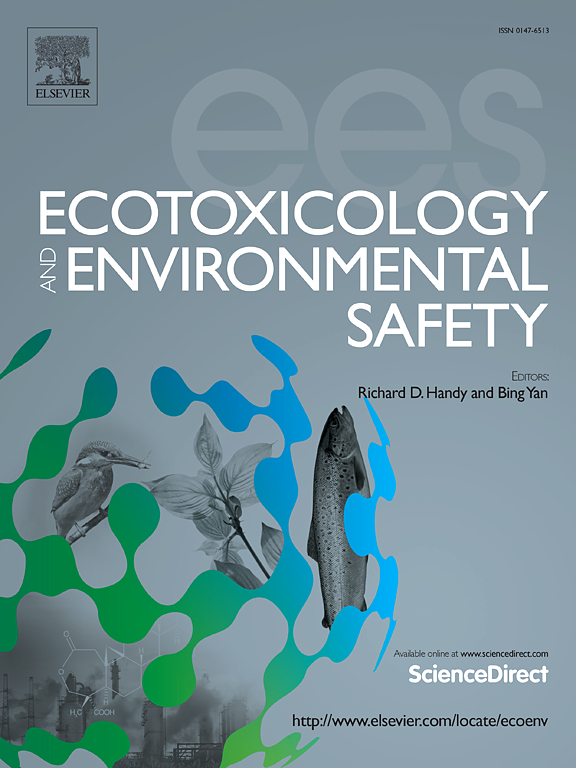orysastrobin及其同分异构体代谢物对斑马鱼胚胎的立体异构体发育毒性:orysastrobin导致心脏发育异常
IF 6.2
2区 环境科学与生态学
Q1 ENVIRONMENTAL SCIENCES
引用次数: 0
摘要
Orysastrobin (OSB)是一种strobilurin杀菌剂,可抑制目标植物病原真菌Qo位点细胞色素bc1的正常氧化还原反应。它在天然湿地和河流中的频繁检测和高浓度引起了人们对其急性毒性和对鱼类的潜在影响的关注。因此,本研究考察了OSB及其立体异构体代谢物F001对斑马鱼(Danio rerio)胚胎的急性毒性。OSB和F001在处理后的胚胎中没有引起大量死亡或抑制孵化。然而,OSB在5.0 mg/L浓度下表现出急性毒性,包括心包和卵黄囊水肿、脊柱弯曲和出血。相比之下,在测试的浓度范围内,F001不会在斑马鱼胚胎中引起这种异常。此外,OSB诱导胚胎心脏发育异常并显著损害心脏功能,这可能是由于心脏发育关键基因kcnn6a和amhc上调所致。在osb处理的胚胎中,观察到肝脏形成的发育延迟。osb诱导斑马鱼胚胎中的活性氧。总之,本研究强调了收集鱼类中OSB和F001的综合毒理学数据以充分了解其环境影响的重要性,强调了迫切需要进行反复定期监测以减轻农业水域、水库和其他水生生态系统的环境风险。本文章由计算机程序翻译,如有差异,请以英文原文为准。
Stereoisomeric developmental toxicity of orysastrobin and its isomeric metabolite in zebrafish (Danio rerio) embryos: Cardiac abnormal development by orysastrobin
Orysastrobin (OSB), a strobilurin fungicide, inhibits the normal redox reactions of cytochrome bc1 at the Qo site of target phytopathogenic fungal species. Its frequent detection and high concentrations in natural wetlands and rivers have raised concerns regarding its acute toxicity and potential effects on fish. Therefore, this study examined the acute toxicities of OSB and its stereoisomeric metabolite F001 on zebrafish (Danio rerio) embryos, an animal model. OSB and F001 did not induce substantial mortality or inhibit hatching in the treated embryos. However, OSB exhibited acute toxicities, including pericardial and yolk sac edemas, spine curvature, and bleeding, at 5.0 mg/L concentration. In contrast, F001 did not induce such abnormalities in zebrafish embryos within the tested concentration ranges. Additionally, OSB induced abnormal cardiac development and significantly impaired heart function in embryos, likely due to the up-regulation of key heart development genes, such as kcnn6a and amhc. In OSB-treated embryos, a developmental delay in liver formation was observed. OSB-induced reactive oxygen species in zebrafish embryos. Overall, this study underscores the importance of gathering comprehensive toxicological data on OSB and F001 in fish to fully understand their environmental impacts, emphasizing the urgent need for repeated periodic monitoring to mitigate the environmental risks posed in agricultural waters, reservoirs, and other aquatic ecosystems.
求助全文
通过发布文献求助,成功后即可免费获取论文全文。
去求助
来源期刊
CiteScore
12.10
自引率
5.90%
发文量
1234
审稿时长
88 days
期刊介绍:
Ecotoxicology and Environmental Safety is a multi-disciplinary journal that focuses on understanding the exposure and effects of environmental contamination on organisms including human health. The scope of the journal covers three main themes. The topics within these themes, indicated below, include (but are not limited to) the following: Ecotoxicology、Environmental Chemistry、Environmental Safety etc.

 求助内容:
求助内容: 应助结果提醒方式:
应助结果提醒方式:


